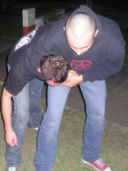Headlock
A headlock is a physical maneuver in wrestling, martial arts, and self-defense techniques, where one person wraps their arms around the head of another, often with the aim of controlling or immobilizing them. This move can be applied from various positions, but it typically involves the attacker's arm encircling the opponent's neck, sometimes locking the attacker's hands together to secure the hold. Headlocks can be used for both offensive and defensive purposes, and they are fundamental techniques taught in many combat sports and self-defense systems.
Types of Headlocks[edit | edit source]
There are several variations of the headlock, each with its specific application and technique. Some of the most common include:
- Side Headlock: The attacker wraps an arm around the opponent's neck from the side, often using the other arm to enhance the grip or control the opponent's body. This type is frequently seen in professional wrestling and judo.
- Front Headlock: In this variation, the attacker applies the headlock from the front, often aiming to control the opponent's posture or to set up a takedown. This form is common in freestyle wrestling and Greco-Roman wrestling.
- Rear Headlock: Applied from behind the opponent, the rear headlock can be used to drag the opponent backward or to the ground. It is a technique often found in self-defense training.
Techniques and Applications[edit | edit source]
The effectiveness of a headlock depends on the technique and the situation. Proper application involves not only securing the hold but also positioning one's body in a way that maximizes control over the opponent while minimizing the risk of counter-attacks. In competitive settings, headlocks can lead to takedowns, pins, or submissions. In self-defense scenarios, they can be used to neutralize a threat or create an opportunity to escape.
Legal and Safety Considerations[edit | edit source]
In some combat sports, certain headlock techniques may be restricted or prohibited due to the risk of injury. For example, moves that apply excessive pressure to the neck or spine can be dangerous and are often banned in amateur competitions. Similarly, in self-defense situations, the legality of using a headlock can depend on the jurisdiction and the context of the encounter, with considerations for reasonable force and self-defense laws.
Training and Education[edit | edit source]
Learning to apply and defend against headlocks is a fundamental aspect of training in many martial arts and combat sports. Proper instruction focuses on technique, safety, and situational awareness, helping practitioners to use headlocks effectively and responsibly.
See Also[edit | edit source]
Search WikiMD
Ad.Tired of being Overweight? Try W8MD's physician weight loss program.
Semaglutide (Ozempic / Wegovy and Tirzepatide (Mounjaro / Zepbound) available.
Advertise on WikiMD
|
WikiMD's Wellness Encyclopedia |
| Let Food Be Thy Medicine Medicine Thy Food - Hippocrates |
Translate this page: - East Asian
中文,
日本,
한국어,
South Asian
हिन्दी,
தமிழ்,
తెలుగు,
Urdu,
ಕನ್ನಡ,
Southeast Asian
Indonesian,
Vietnamese,
Thai,
မြန်မာဘာသာ,
বাংলা
European
español,
Deutsch,
français,
Greek,
português do Brasil,
polski,
română,
русский,
Nederlands,
norsk,
svenska,
suomi,
Italian
Middle Eastern & African
عربى,
Turkish,
Persian,
Hebrew,
Afrikaans,
isiZulu,
Kiswahili,
Other
Bulgarian,
Hungarian,
Czech,
Swedish,
മലയാളം,
मराठी,
ਪੰਜਾਬੀ,
ગુજરાતી,
Portuguese,
Ukrainian
Medical Disclaimer: WikiMD is not a substitute for professional medical advice. The information on WikiMD is provided as an information resource only, may be incorrect, outdated or misleading, and is not to be used or relied on for any diagnostic or treatment purposes. Please consult your health care provider before making any healthcare decisions or for guidance about a specific medical condition. WikiMD expressly disclaims responsibility, and shall have no liability, for any damages, loss, injury, or liability whatsoever suffered as a result of your reliance on the information contained in this site. By visiting this site you agree to the foregoing terms and conditions, which may from time to time be changed or supplemented by WikiMD. If you do not agree to the foregoing terms and conditions, you should not enter or use this site. See full disclaimer.
Credits:Most images are courtesy of Wikimedia commons, and templates Wikipedia, licensed under CC BY SA or similar.
Contributors: Prab R. Tumpati, MD

